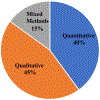Attitudes and Experiences Surrounding Female Genital Mutilation/Cutting in the United States: A Scoping Review
- PMID: 36542264
- PMCID: PMC10981529
- DOI: 10.1007/s10903-022-01437-2
Attitudes and Experiences Surrounding Female Genital Mutilation/Cutting in the United States: A Scoping Review
Abstract
To identify research and gaps in literature about FGM/C-related attitudes and experiences among individuals from FGM/C-practicing countries living in the United States, we conducted a scoping review guided by Arksey and O'Malley's framework. We searched Medline (OVID), Embase (OVID), PubMed, and SCOPUS and conducted a grey literature search for studies assessing attitudes or experiences related to FGM/C with data collected directly from individuals from FGM/C-practicing countries living in the United States. The search yielded 417 studies, and 40 met the inclusion criteria. Findings suggest that women and men from FGM/C-practicing countries living in the United States generally oppose FGM/C, and that women with FGM/C have significant physical and mental health needs and have found US healthcare providers to lack understanding of FGM/C. Future research can improve measurement of FGM/C by taking into account the sociocultural influences on FGM/C-related attitudes and experiences.
Keywords: Female circumcision; Female genital mutilation/cutting; Migrant health; Scoping review; United States.
© 2022. This is a U.S. Government work and not under copyright protection in the US; foreign copyright protection may apply.
Figures
References
-
- WHO. Eliminating female genital mutilation: an interagency statement-OHCHR, UNAIDS, UNDP, UNECA, UNESCO, UNFPA, UNHCR, UNICEF, UNIFEM. World Health Organization; 2008.
-
- Shell-Duncan B, Naik R, Feldman-Jacobs CA. A State-of-the-Art Synthesis on Female Genital Mutilation/Cutting: What Do We Know Now? New York: Population Council. 2016.
Publication types
MeSH terms
Grants and funding
LinkOut - more resources
Full Text Sources
Miscellaneous



